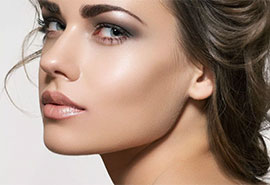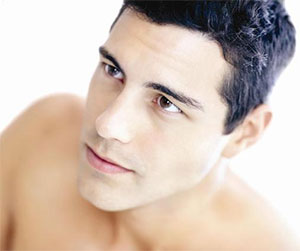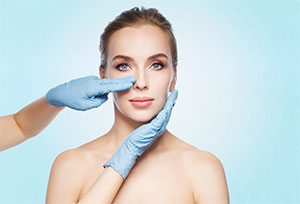
Who is a candidate for aesthetic nose surgery ?
Two groups of patients can be considered as candidates for aesthetic nose surgery: In the first group, there are patients with nasal obstruction, nasal septum deviation (cartilage-bone convexities), and enlarged turbinates, who demand an aesthetic improvement in their nose while planning a functional surgery. In the second group, there are patients who demand only an aesthetic improvement without the problem of nasal obstruction.
Is there an age limit for surgery ?
Considering cartilage-bone development, aesthetic nose surgery is classically performed to patients older than 18 years of age, except for special cases.
Can the surgery be done in all seasons ?
Aesthetic nose surgery can be performed in all seasons if the rules regarding the post-surgery period are followed. However, when these rules are taken into account, the majority of patients do not prefer to have surgery in the summer.
Which techniques are used in aesthetic nose surgery ?
There are two basic aesthetic nose surgery techniques, namely open technique and closed technique.
How is closed technique aesthetic nose surgery done ?
In this technique, incisions are made inside the nose. With delivery technique, alar cartilages can be exposed and tipplasty can also be performed.
What are the advantages and disadvantages of the closed technique ?
The operation takes generally a shorter time than the open technique, since an incision is not made in the wall called ‘columella’ located in the middle of both nostrils. However, it might be difficult to perform rhinoplasty in severely crooked noses, revision cases or difficult tip with this technique.
How is open technique aesthetic nose surgery done ?
In the open technique, unlike the closed technique, an incision is made on the columella.

What are the advantages and disadvantages of the open technique ?
In the open technique, it is possible to have more anatomical control over the entire nose and especially the tip of the nose. The tip of the nose can be shaped more easily. Again, it is easier to perform middle vault reconstruction, and fix very severely crooked noses. This method is also preferred for most of the revision surgeries. On the other hand, the operation time is longer compared to the closed technique.
Which technique do you use more ?
I perform rhinoplasty with open technique in 80-90 % of the cases.
What type of anaesthesia do you perform your surgeries with ?
Rhinoplasty can be performed under general anaesthesia or under sedation and local anaesthesia. I prefer to perform all my surgeries under general anaesthesia, both for patient’s comfort and mine.
How many hours does open technique rhinoplasty surgery take ?
I perform open technique rhinoplasty in about 3 hours on average. Depending on the nose, this may take longer.
Do you take photos before surgery ?
Before every rhinoplasty operation, I always take pictures of the nose in 6 standard poses. I analyse the nose and face through these photographs and discuss the surgery plan with the patient. It is also important to keep them for documentation, and to compare them with postoperative photos.
Do you make simulations on the computer before the surgery ?
Simulation is made on lateral view photos, and provides an idea of possible result. I find simulations useful, it helps me to understand my patient, and vice versa, therefore make it commonly.

What should be considered before the operation ?
The use of some medications such as aspirin should be discontinued at least 1 week prior the surgery. At the time of the operation, the patient should not have an infection, especially an upper respiratory tract infection.
Will there be bruising or swelling after the surgery ?
Compared to past years, thanks to the development of the techniques and tools used, hypotensive anaesthesia, and the application of ice peroperatively and immediately after the operation, postoperative bruising and swelling is considerably reduced.
Is rhinoplasty a painful operation ?
Contrary to common belief, rhinoplasty is not a painful operation. A simple pain killer such as paracetamol is generally sufficient after the surgery. Most of the patients do not even need paracetamol much.
Is nasal packing used in surgery ?
As with deviation surgery, nasal packing has been the most frightening aspect of aesthetic nose surgeries over the years. The classical nasal packings used in the past were completely blocking the nose after the surgery,bleeding and pain could occur when removing the packings. I have been using Silicone Doyle splints for many years, which allow the patient to breathe through the air channels immediately after the surgery, unless they are blocked by a blood clot, and as they do not stick to the nose they do not cause pain or bleeding when they are removed.
Do I need to stay in the hospital after the surgery ?
I recommend an overnight stay in the hospital so that the ice pack application can be done more comfortably and accurately.
How is the postoperative course ?
After the surgery, the air channels in the silicone splints inside the nose are tried to be kept open by rinsing them with special saline solutions or sprays. Ice is applied around the eyes for the first 24 hours. If bruising and swelling occur, 80-90% of this disappear within the first week-10 days. If necessary, ointments that help bruising and oedema disappear more quickly can be applied around the eyes. These silicone splints are removed two or three days after the operation (it may be a little longer if necessary). On the sixth or seventh day, the cast is removed, and tapes are placed over the nose again for 5 days. So on the 11th-12th day, nothing remains on the nose. The patient is seen once a week for a total of 3-4 weeks, and intranasal cleaning is done. During this period, nasal rinsing with saline solutions and some moisturizing sprays reduce nasal crusting. On the 6th month after the operation, oedema is considered to be totally resolved. Post-operative photos can be taken starting from the 3rd month after the surgery.
In the first week after the operation, the patient should not work. While having shower, the body and hair should be washed separately. The teeth should be brushed with a soft toothbrush (such as a baby toothbrush) and facial gesture including laughing should be avoided as much as possible again in the first postoperative week. The patient is advised not to smoke especially in the first week after the operation, as smoking negatively affects the healing process. In addition, the patient should not sunbathe for 6 weeks after the surgery and should not use glasses, including sunglasses, for 4 months.
What complications can occur after surgery ?
Complications that may occur after aesthetic nose surgery include bleeding, septal haematoma ( blood accumulation in the midline wall of the nose), infection, adhesions in the nose (synechia) and septal perforation (formation of a hole in the midline wall of the nose), nasal valve problems (narrowing of critical structures of the nose leading to nasal obstruction), and unsatisfactory aesthetic result . Septal perforation is encountered around 1-2% following an operation performed with a modern technique. It usually does not cause any complaints. In some patients, it may cause nasal crusting, bleeding, nasal obstruction and a whistling sound while sleeping. Although it can be fixed with a second surgery if necessary, the rate of patients who will need it is very low.
If an aesthetically or functionally unsatisfactory result occurs, a revision surgery may be required with an average of 10% probability. This second operation, is usually not as extensive as the first one. It is possible to avoid all these complications to a great extent with meticulous surgery and appropriate postoperative care.


